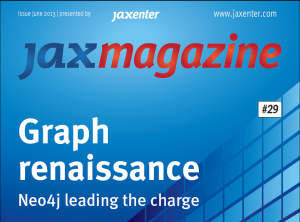Written by Michael Hunger, Developer Evangelist and Head of Spring Integration, Neo Technology. Article published in JAX, June 27, 2013
 If you’ve attended a Java conference in the past year, or in fact even just glanced at the agenda, chances are you will have come across the name neo4j.
Since releasing the 1.0 version back in 2010, the open source, Java-implemented graph database has really grown in popularity, effectively leading the charge for the set of NoSQL datastores as a whole.
Demand for graph databases has arguably reached fever pitch at least with consumers, due to the likes of Twitter, Facebook and Google making big noises about their in-house creations.
In this issue of JAX Magazine, we ask why is it only now that the enterprise sector has cottoned on to the benefits?
Neo Technology’s Michael Hunger explains how graph databases, with a particular focus on Neo4j, have allowed us to reimagine relationships and derive additional insights thanks to a structure of nodes and edges.
This month has also seen the release of Java EE 7, three years on from the last major enterprise Java edition. Chris Vignola introduces us to one of the key components, JSR 352, which makes batch processing far easier than previously.
Our final tutorial in this issue comes from Charles Moulliard, who explains the ins and outs of Apache Camel, the dexterous integration framework.
Elsewhere, we shine the spotlight on Codenvy, a new cloud-based IDE spun out of eXo. Initially beginning just an experiment into looking at multi-tenancy in the JVM, the development environment has grown into its own project, and jumped on the back of various cloud platforms. We ask CEO Tyler Jewell is it time for everyone to step away from the desktop and move to the browser?
We’ve also managed to squeeze in a chat with Elasticsearch’s Shay Banon to discuss the new company built from the foundations of Apache Lucene. With clients such as SoundCloud, Github and FourSquare all using the RESTful search engine, we ask what’s next for Elasticsearch, as well as looking at the architecture behind it.
Read the Full Article Here.
You can Download a copy of the PDF here.
If you’ve attended a Java conference in the past year, or in fact even just glanced at the agenda, chances are you will have come across the name neo4j.
Since releasing the 1.0 version back in 2010, the open source, Java-implemented graph database has really grown in popularity, effectively leading the charge for the set of NoSQL datastores as a whole.
Demand for graph databases has arguably reached fever pitch at least with consumers, due to the likes of Twitter, Facebook and Google making big noises about their in-house creations.
In this issue of JAX Magazine, we ask why is it only now that the enterprise sector has cottoned on to the benefits?
Neo Technology’s Michael Hunger explains how graph databases, with a particular focus on Neo4j, have allowed us to reimagine relationships and derive additional insights thanks to a structure of nodes and edges.
This month has also seen the release of Java EE 7, three years on from the last major enterprise Java edition. Chris Vignola introduces us to one of the key components, JSR 352, which makes batch processing far easier than previously.
Our final tutorial in this issue comes from Charles Moulliard, who explains the ins and outs of Apache Camel, the dexterous integration framework.
Elsewhere, we shine the spotlight on Codenvy, a new cloud-based IDE spun out of eXo. Initially beginning just an experiment into looking at multi-tenancy in the JVM, the development environment has grown into its own project, and jumped on the back of various cloud platforms. We ask CEO Tyler Jewell is it time for everyone to step away from the desktop and move to the browser?
We’ve also managed to squeeze in a chat with Elasticsearch’s Shay Banon to discuss the new company built from the foundations of Apache Lucene. With clients such as SoundCloud, Github and FourSquare all using the RESTful search engine, we ask what’s next for Elasticsearch, as well as looking at the architecture behind it.
Read the Full Article Here.
You can Download a copy of the PDF here.
Keywords: Graph Databases • JAX • Michael Hunger • neo4j